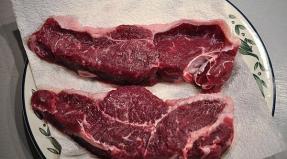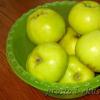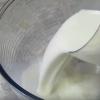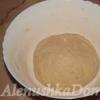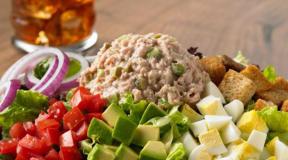Recipe for making Jack Daniels whiskey at home. Jack Daniels whiskey - the right recipe at home Make Jack Daniels
As you know, the production of authentic Jack Daniels uses water from the Cave Spring spring located near the distillery, filtration charcoal from sugar maple growing in North America and new, freshly charred American white oak barrels. It is more than difficult to get hold of all these components in our area. But otherwise, real masters of their craft will be quite capable of reproducing the process of making so-called Tennessee whiskey.
List of ingredients for Jack Daniels
Corn flour – 80% of the total grain mass;
Rye flour – 8%;
Ground barley (white) malt – 12%;
Yeast – 5 g dry or 25 g pressed per 1 kg of grain;
Water (with minimal iron content) – 400% of the total mass of grains.
Stages of making Jack Daniels whiskey
Step 1
Pour corn and rye flour into a cauldron and add water heated to a temperature of 50-55°C (keep in mind that the vessel should not be more than three-quarters full). At the same time, pour water without haste, constantly stirring the contents of the container to avoid the formation of lumps. Raise the temperature of the mixture to 60°C and keep it in this state for 15 minutes, continuing to stir constantly. Next, bring the contents of the boiler to a boil and simmer for an hour to obtain a completely homogeneous porridge-like mass.
Step 2
Remove the kettle from the heat, wait until the future mash mash cools to a temperature of 65-67°C and add malt, mixing everything again. Wrap the container with the resulting mass, whose temperature should be 63-65°C, tightly in several layers of heat-resistant fabric and place it in a warm place for 2 hours. At the same time, during the first hour the mash must be intensively stirred every 15 minutes. It is also very important not to allow the mixture to cool below 55°C. The entire above-mentioned filigree process is called hot saccharification of starch-containing raw materials. This entire procedure, including subtle manipulations with the temperature of the grain mash, can be significantly simplified by using the cold saccharification method. However, it is worth considering that the distillery that produces Jack uses the classic “hot” method, which does not allow the addition of any third-party enzymes.
Step 3
After two hours, the mash must be quickly transferred (so as not to turn sour) into a fermentation container, cooled to a temperature of 25-28°C and yeast added to it (if we are talking about pressed yeast, it must first be fermented in a small amount of water). The vessel with the wort, equipped with a lid with a water seal, should be placed in a dark, warm and quiet place for the duration of fermentation (from 2 to 6 days). At the same time, the temperature of the substance should not go beyond the same 25-28°C.
Step 4
The preparation of the fermented wort depends on the distiller (in any case, it is highly desirable that it be copper). If your unit is equipped with a steam generator, then you can load it directly from the container. If you have a simpler apparatus (by the way, this is exactly what Jack producers still use), the liquid component of the wort should be filtered or squeezed through cheesecloth. The following method is especially captivating with its simplicity: the wort is poured into a gauze bag, placed in a metal bucket ahead of time, then the contents of the bag are carefully and firmly squeezed into the mentioned container, from which the liquid component of the wort is sent straight to the distillation cube. By the way, part of the spent cake can, according to American tradition, be added as an additional starter to a new portion of the future mash.
Step 5
The raw materials loaded into the distiller are subjected to double distillation. Primary distillation occurs without separation into fractions. The result is approximately thirty-proof raw alcohol, which is sent for re-distillation. This time, there is a need to cut off the “heads” and “tails”. At the same time, in order to avoid the risk of spoiling the final product, the head and tail fractions should each contain 10% of the total volume of distillate. As a result of repeated distillation, Jack Daniels producers obtain grain alcohol with a strength of 69-70 degrees. Most likely, in your case, this figure will be slightly lower, due to the technical parameters of your distiller.
Step 6
The resulting grain moonshine must be passed through a coal column equipped with an additional cotton filter. At the same time, it is quite acceptable to replace maple charcoal with the coconut equivalent available in our conditions. We should also not forget that an important condition for high-quality distillate purification is fine crushing or even grinding of charcoal. Ideally, it should be a coarse powder.
Step 7
The future drink should be aged in a charred oak barrel or on well-roasted oak chips. This is done not in special cellars, but in above-ground premises at natural temperature. Considering the small volumes of containers in which your drink will be aged, for a good result it is enough to wait 8-10 months (although some, especially impatient people, argue that it is quite acceptable to divide this period in two). At the same time, it is believed that the optimal container for aging small batches of corn a la Jack are small-sized oak barrels with a volume of 10 to 50 liters.
If in the end you want to get something similar to Gentleman Jack or, what the hell, Single Barrel, your distillate should be subjected to carbon filtration again before bottling. Then, depending on the softness and balance of the resulting corn, it is bottled at 40, 43, 45 or 47 turns and sent to your personal bar.
Video recipe for Jack Daniels whiskey
Jack Daniels
As is known, in the production of authentic Jack Daniels Water from nearby Cave Spring, charcoal from North American sugar maple trees, and new, freshly charred American white oak barrels are used.
It is more than difficult to get hold of all these components in our area. But otherwise, real masters of their craft will be quite capable of reproducing the process of making so-called Tennessee whiskey.
List of ingredients for Jack Daniels
Corn flour – 80% of the total grain mass;
Rye flour – 8%;
Ground barley (white) malt – 12%;
Yeast – 5 g dry or 25 g pressed per 1 kg of grain;
Water (with minimal iron content) – 400% of the total mass of grains.
Stages of making Jack Daniels whiskey
Step 1 Pour corn and rye flour into a cauldron and add water heated to a temperature of 50-55°C (keep in mind that the vessel should not be more than three-quarters full). At the same time, pour water without haste, constantly stirring the contents of the container to avoid the formation of lumps.
Raise the temperature of the mixture to 60°C and keep it in this state for 15 minutes, continuing to stir constantly. Next, bring the contents of the boiler to a boil and simmer for an hour to obtain a completely homogeneous porridge-like mass.
Step 2 Remove the kettle from the heat, wait until the future mash mash cools to a temperature of 65-67°C and add malt, mixing everything again. Wrap the container with the resulting mass, whose temperature should be 63-65°C, tightly in several layers of heat-resistant fabric and place it in a warm place for 2 hours.
At the same time, during the first hour the mash must be intensively stirred every 15 minutes. It is also very important not to allow the mixture to cool below 55°C. The entire above-mentioned filigree process is called hot saccharification of starch-containing raw materials.
This entire procedure, including subtle manipulations with the temperature of the grain mash, can be significantly simplified by using the cold saccharification method. However, it is worth considering that the distillery that produces Jack uses the classic “hot” method, which does not allow the addition of any third-party enzymes.
Step 3 After two hours, the mash must be quickly transferred (so as not to turn sour) into a fermentation container, cooled to a temperature of 25-28°C and yeast added to it (if we are talking about pressed yeast, it must first be fermented in a small amount of water).
The vessel with the wort, equipped with a lid with a water seal, should be placed in a dark, warm and quiet place for the duration of fermentation (from 2 to 6 days). At the same time, the temperature of the substance should not go beyond the same 25-28°C.
Step 4 The preparation of the fermented wort depends on the distiller (in any case, it is highly desirable that it be copper). If your unit is equipped with a steam generator, then you can load it directly from the container.
If you have a simpler apparatus (by the way, this is exactly what Jack producers still use), the liquid component of the wort should be filtered or squeezed through cheesecloth.
The following method is especially captivating with its simplicity: the wort is poured into a gauze bag, placed in a metal bucket ahead of time, then the contents of the bag are carefully and firmly squeezed into the mentioned container, from which the liquid component of the wort is sent straight to the distillation cube.
By the way, part of the spent cake can, according to American tradition, be added as an additional starter to a new portion of the future mash.
Step 5 The raw materials loaded into the distiller are subjected to double distillation. Primary distillation occurs without separation into fractions.
The result is approximately thirty-proof raw alcohol, which is sent for re-distillation. This time, there is a need to cut off the “heads” and “tails”. At the same time, in order to avoid the risk of spoiling the final product, the head and tail fractions should each contain 10% of the total volume of distillate.
As a result of repeated distillation, Jack Daniels producers obtain grain alcohol with a strength of 69-70 degrees. Most likely, in your case, this figure will be slightly lower, due to the technical parameters of your distiller.
Step 6 The resulting grain moonshine must be passed through a coal column equipped with an additional cotton filter. At the same time, it is quite acceptable to replace maple charcoal with the coconut equivalent available in our conditions.
We should also not forget that an important condition for high-quality distillate purification is fine crushing or even grinding of charcoal. Ideally, it should be a coarse powder.
Step 7 The future drink should be aged in a charred oak barrel or on well-roasted oak chips. This is done not in special cellars, but in above-ground premises at natural temperature.
Considering the small volumes of containers in which your drink will be aged, for a good result it is enough to wait 8-10 months (although some, especially impatient people, argue that it is quite acceptable to divide this period in two).
At the same time, it is believed that the optimal container for aging small batches of corn a la Jack are small-sized oak barrels with a volume of 10 to 50 liters.

If in the end you want to get something similar to Gentleman Jack or, what the hell, Single Barrel, your distillate should be subjected to carbon filtration again before bottling.
Then, depending on the softness and balance of the resulting corn, it is diluted to a strength of 40, 43, 45 or 47 revolutions and bottled.
The Jack Daniels drink, beloved by many, not only has a unique taste, but also emphasizes the status of the person who drinks it. You will learn about the history of its origin, production technology and features of use, as well as how not to buy a fake bottle of whiskey from this article.
History of the Jack Daniels brand
Jack Daniel's whiskey is the true symbol of all alcoholic beverages produced in the USA. They even came up with a special subcategory for it - “Tennessee,” named after the state where the original drink is produced.
The history of Jack Daniels alcohol began in the early 50s. XIX century, in the town of Lynchburg, located in the US state of Tennessee. Then the clergyman Dann Call hired seven-year-old Jasper “Jack” Daniel as his assistant in the production of whiskey. Even at that age, the boy showed great ingenuity and commercial acumen.
From his hand, the raw whiskey began to be filtered through a thick layer of coal. And the best coal was considered only that which was obtained from burnt sugar maple wood. The dimensions of the filtration layer exceeded three meters in thickness. After this treatment, the whiskey became much softer, its taste was strikingly different from the cheap cognac and bourbon that were popular at that time.
Bourbon was made only from corn, and barley and rye were not added to the primary mixture. Only the one produced in Kentucky is considered real bourbon. And Jack Daniel's from Tennessee is whiskey in its purest form.
The basis of cognac is grape alcohol, which gives the drink a bitter taste with a high percentage of strength. Therefore, your favorite alcohol from a square bottle also does not apply to cognac.
They carefully selected the material of the containers into which the drink was placed after filtration. Barrels must be made of white oak wood. The inside was fired to caramelize the natural juices and give the whiskey a sweet flavor.
Little Jasper also discovered a source of pure water, which was used in the production of the raw drink. Its use improved the taste of whiskey.
Thanks to his talents, Jasper opened his own winery at the age of 13, and at 16 he received permission to legally produce alcohol.
He was so carried away by commercial affairs that during all this time he did not start a family. Therefore, Lam's nephew Jesse Motlow inherited the business in 1911 after Jack's death. Motlow ran the business until 1947. During this period, the world was involved in World War II and America was under Prohibition, prohibiting the sale of alcoholic beverages.
But despite the difficulties, the plant did not go bankrupt. And soon the distillery was registered as “Jack Daniels Distillery, Lem Motlow, Prop., Inc.”
After winning the St. Louis Luxury Exposition in 1904, Jack Daniels began exporting abroad with great success.
Master distiller Jack Rair began a new recipe for whiskey production in 1988. To make the drink softer, it was subjected to double filtration. The first time is before bottling into barrels. After which the drink was infused for 4 years, and it was again softened with charcoal. Next, it was planned to bottle it into glass containers.
Today, the head of the production of the famous alcohol is Jeff Arrnet, the seventh leader, who began his duties in 2008. Every year, the position of Jack Daniels in the global alcoholic beverages market is only strengthened. And the distillery where it is produced is considered the oldest whiskey distillery in the United States.
The face of whiskey is its bottle
Thanks to the unusual shape of the bottle, Jack Daniels whiskey is recognizable at first sight on a store display or in a bar. But first, alcohol was poured into classic round bottles made of clay. The oak stopper was engraved with the word “Master Jack.”
In 1985, whiskey began to be bottled in square glass bottles with screw caps. Containers of this shape were first used in the production of alcohol.
Today, bottles of Jack Daniels whiskey on a swing are very popular - a convenient device for filling glasses, in which the bottle tilts to the side. They decorate any noisy feast and can be a great gift for a friend.
The label contains all the information about the bottling date, strength of the drink, barrel number and container volume.
Production technology
Whiskey can be either single malt or blended. In the production of the first, only barley malt is used as a basis. Additional ingredients, according to true connoisseurs, only spoil the aroma and taste. If a blend of alcohols (both grain and malt) is taken as the basis for the primary raw material, then the result is blended whiskey.
The original composition of Jack Daniel's blended whiskey has not changed over the years. In the production of raw materials the following are used:
Corn grains – 80%;
Rye – 12%;
Barley malt – 8%.
These ingredients are added to purified spring water, after which the mixture is fermented with sour wort. Then the raw material is filtered through a three-meter layer of coal. At the same time, Jack Daniels almost completely gets rid of fusel oils and sucrose and glucose.
After cleaning, the whiskey is placed in oak barrels for aging. The manufacturer determines the readiness of alcohol for bottling by tasting, so the whiskey may not have the classic 4-year aging.
Additional Information. Until 1970, Jack Daniel's was sold in 25- and 12-year-old varieties.
Varieties "Jack Daniels"
These days, the leading US alcohol concern produces several varieties of whiskey.

1. Classic variety - a blend of different alcohols. This drink has a mild taste with light shades of vanilla and caramel. Strength – 40 degrees.

2. is a representative of premium whiskey. The very mild taste of alcohol is obtained thanks to double filtration, and the strength is slightly higher than the standard - 45 degrees.

3. Whiskey Silver Select It has a fairly strong taste with obvious oak undertones. Its strength is 50 degrees.

4. has a 35-degree strength and a special aftertaste of honey. This effect is achieved by mixing classic Tennessee whiskey with honey liqueur.

5. – a type of whiskey with 43% alcohol content. It will suit true connoisseurs of Jack Daniels; its taste combines notes of gingerbread, honey, bananas, mocha, vanilla and black pepper.
These most popular whiskeys are often counterfeited. Therefore, you need to be careful when buying alcohol in any store (on the Internet, in duty-free and others).
How to spot a fake?
Pay attention to the bottle and label. In the original drink:
Sharp corners of the bottle;
The embossing on the container hangers is clear and not blurry;
“Pot-bellied” neck and the presence of a dispenser;
Black plastic lid with 1 ribbed band and black protective film;
The embossed label, which occupies three sides of the bottle, without traces of glue, is glued evenly.
It is also recommended to carefully study the original label of the drink so that a counterfeit can be identified through a superficial inspection. So, on real whiskey you will not find a single inscription in Russian. Also, the EI code must be indicated at the bottom of the sticker - numbers indicating the bottling date and barrel number.
Ways to drink whiskey
True connoisseurs of blended whiskey drink it after meals, undiluted, in small portions. Crushed ice may be added occasionally.
Whiskey is also added to cocktails - with ice and cola or chilled apple juice. Traditionally, the drink is eaten with slices of lemon, but gourmets prefer to savor its oaky-nutty taste in small sips without adding any food.
Pure alcohol is served in tulip-shaped glasses, and cocktails can be mixed in wide glasses with a thick bottom.
Serving temperature is from 18 to 21 degrees.
How to make whiskey at home?
To make your own Jack Daniels, you need to take 80% corn grits, 12% ground barley malt and 8% rye malt, also crushed. Dry ingredients need to be filled with hot water - 20 liters is enough for 8 kg.
You need to mix the mixture well, wrap it in a warm blanket and place it in a warm place. The ideal temperature for fermentation is 55-64 degrees. Every 15 minutes you need to stir the resulting substance. After an hour, it needs to be cooled to a temperature of 24-28 degrees and maintained at this level constantly.
After 10 hours, you need to add any yeast - for 8 kg, 50 g is enough. The container is closed with a water seal (one end of the tube is placed in the container and sealed well, and the other end is placed in a glass of water). With its help, carbon dioxide is released, which is formed during fermentation.
After 5 days, the fermentation process will end and you can begin filtering. The container with mash should be covered with several layers of gauze and turned into another container. After a few hours, the liquid will be filtered and you can distill it. To do this, it is better to use copper moonshine stills, which additionally rid the substance of harmful impurities.
The first distillation at the end can produce a drink of low strength. In this case, you need to repeat the entire distillation process.
The main goal of the JackDaniels whiskey manufacturer is to achieve a balance of taste and aroma. That is why the drink is so popular all over the world. It's up to you to decide which type of whiskey you choose. Have a great time!
Jack Daniels whiskey is deservedly considered the most famous and sought-after alcohol, sales of which are constantly growing from year to year. It represents the entire assortment of American-made alcohol, and is secretly considered a national treasure of the United States. Find out the history of how they drink whiskey in America, what is real Jack Daniels made from?
In the article:
An excursion into the history of Jack Daniels
The history of Jack Daniels whiskey began when in 1875 a certain Jasper Daniel decided to found his own distillery in the small town of Lynchburg. Time has shown that Jasper had not only skill, but also commercial talent, thanks to which a small factory turned into a huge alcohol concern in just 50 years.
The most interesting thing is that Daniel became the owner of the distillery at the age of 13, and three years later he received a license to produce alcohol on a completely legal basis. It is also noteworthy that the owner of the distillery where little Danny came to work (at the age of 6-7 years, such were the realities of that time) was the priest Dann (this name is definitely significant for the history of whiskey) Coll. It was he who became the distillery teacher for the future founder of the world famous brand. Thus, the servant of God took the most active, albeit indirect, part in the history of the development of whiskey.
Seeing the boy’s intelligence and diligence, Father Dann initiated him into all the intricacies of production, later made him his business partner, and after the death of the distiller’s priest, Jasper becomes the full and sole owner of the business.
Jasper's enthusiasm was so great that it completely absorbed the creator of the famous alcoholic drink: during his life he did not have time to marry and have offspring, and therefore bequeathed his alcohol business to his brother's son. The nephew did not disappoint, and in 1941 whiskey became the subject of increased government attention. It was included in the list of branded alcohol of the state of Tennessee and ordered to be separated from the concept “”. Why did it happen?
How Jack Daniel's whiskey is made
It was the way Jack Daniels whiskey is made that motivated the US government to abandon the idea of calling the product bourbon.
The fact is that the production process of the legendary drink uses Lincoln technology - a specific process of filtering alcohol through charcoal from maple trees. The alcohol itself consists of 80% corn distillate, 12% rye distillate and only 8% barley distillate. The basis for mixing all the ingredients is spring water, and the whiskey itself has a 40% yield.
Thanks to a specific distillation process, the drink has almost no fusel oils and a specific taste from corn. Charcoal from American maple wood, through which the alcohol passes, gives it softness and unique taste.
Jack Daniels whiskey recipe at home
 Since no one hides the original ingredients of the drink, craftsmen did not miss the opportunity to experiment with them and develop a recipe for Jack Daniels whiskey at home. It is proposed to do the following as preparatory work:
Since no one hides the original ingredients of the drink, craftsmen did not miss the opportunity to experiment with them and develop a recipe for Jack Daniels whiskey at home. It is proposed to do the following as preparatory work:
- Take equal amounts of rye and barley malt, add the same amount of corn grits to it and pass everything through a meat grinder.
- The dry mixture is poured with just boiled water. Make sure that there is 2.5 times more liquid than the grain part.
- The prepared “wort” is placed for an hour in a warm place, where the temperature will be constantly maintained in the region of 55-63°C. All this time, the mixture is often stirred, and then naturally cooled to 25-28°C.
- After 12 hours, you can add yeast at the rate of 50 g per 7-8 kg of wort. The mash is poured into a bottle, the latter is equipped with a water seal and sent to a warm place where there is not the slightest vibration.
The distillation stage begins after 3-5 days, and it begins with the distillation of the wort through a special moonshine unit at a temperature of 95°C. This is the only way to rid whiskey of fusel oils. In order to soften the drink, I pass it through a homemade filter made of cotton wool and charcoal. Well, if you want to get a noble version of alcohol, you need to roll it in a charred oak barrel for 4 months.
How many degrees is homemade Jack Daniels whiskey? It depends on your ability to prepare homemade alcohol. Ideally, this figure should be as close as possible to forty.
How to distinguish Jack Daniels whiskey from a fake?
 How to distinguish Jack Daniels whiskey from a fake, especially if the number of counterfeits is growing at an alarming rate every year? Here you need to remember the following distinctive features of the original drink:
How to distinguish Jack Daniels whiskey from a fake, especially if the number of counterfeits is growing at an alarming rate every year? Here you need to remember the following distinctive features of the original drink:
- when shaken, alcohol produces large bubbles that do not dissolve in the bulk for a long time;
- true whiskey will slowly flow down the walls of the bottle, while a fake liquid will do this in a few seconds;
- A rare fake Jack Daniels will show the presence of a tax stamp. In turn, it must be glued neatly and evenly, without glue drips or “wrinkles”;
- as a rule, the surrogate is sealed with a metal stopper, while for the original only a plastic stopper is used;
- Jack Daniels honey whiskey, like all its other types, is bottled in a square bottle with a clear and recognizable engraving;
- all inscriptions on the label must be clear, somewhat convex and neat;
- there can be no hint on the label that the bottle contains “Scotch-type” whiskey. Such alcohol simply does not exist;
- Premium or Deluxe inscriptions indicate the originality of the product more clearly than anything else.
How and with what to drink Jack Daniels?
 The answer to the question of how to properly drink Jack Daniels whiskey is as old as time – in its purest form, of course! This is the only way to fully enjoy its taste and understand why this particular drink has become an unspoken symbol of the USA. If it’s difficult for you to drink alcohol without snacking, try to limit yourself to a slice of lemon. Well, when this option seems unrealistic, try it in combination with:
The answer to the question of how to properly drink Jack Daniels whiskey is as old as time – in its purest form, of course! This is the only way to fully enjoy its taste and understand why this particular drink has become an unspoken symbol of the USA. If it’s difficult for you to drink alcohol without snacking, try to limit yourself to a slice of lemon. Well, when this option seems unrealistic, try it in combination with:
- Coca-Cola, which softens the drink and gives it new taste characteristics;
- sparkling mineral water;
- ice, which makes the alcohol not so hot, slowly reduces its strength and reduces the smell from the evaporation of alcohol.
The answer to the question of how to properly drink Jack Daniels whiskey is as old as time – in its purest form, of course!
They should be tulip-shaped; for mixed with mineral water or cola, it is better to choose wide glasses with a thick bottom.
Do not heat the drink as this will worsen its taste. But you shouldn’t cool it too much either, otherwise the aroma will be damaged. It is ideal if the whiskey is heated to 18-21 degrees.
The question is, Jack Daniels has no right to exist at all. Alcohol of this type will not tolerate any snack! Moreover, the drink cannot even be washed down with juices or plain water. The maximum is a slice of pear, and that’s it! It is unacceptable to mix different types of Daniels or drink it mixed with other alcohol, “sip” whiskey through your teeth or drink through a straw.
Jack Daniels - interesting facts
Jack Daniels whiskey began to be bottled in square bottles, which became the hallmark of the brand, in 1897.

What does the inscription “Old No.” hide? 7"
The name of one of the popular brands Old No. 7 is associated with the state registration number of the distillery where this drink was produced. After the district boundaries were changed, the plant received number 16, but the name of the brand, which had managed to gain popularity, was not changed.
The drink's popularity surged in 1904, when Jack Daniel's whiskey received a gold medal at the World's Fair in St. Louis.
Although Jack Daniels is almost the only American "real" whiskey, North American trade agreements classify the drink as "bourbon whiskey." In accordance with these documents, as well as the laws of Canada, only brands imported from Europe can bear the name “whiskey”.
Let's first briefly outline what's great about Jack Daniel's Whiskey! This drink is not ordinary whiskey, but American. Unlike most other varieties, Jack Daniels is made not only from barley malt, but also from corn and rye. In addition, the drink is carefully filtered using a special technology and aged in American white oak barrels, charred from the inside. It would seem, how can you do something like this yourself, without having practically any equipment at hand? It turns out that nothing is impossible, and we will prove it to you!
So, an integral part of the production of Jack Daniels whiskey is carefully selected ingredients. All of them can easily be purchased at a hypermarket, bought at the market, or even produced yourself if you have the time, desire and land.
What is Jack Daniel's whiskey made from? So, the composition of whiskey:
- Corn grits - 80%;
- Ground barley malt (or, in other words, white) - 12%;
- Ground rye malt (red) - 8%.

If you cannot purchase ground malt, you can grind it yourself. For these purposes, you can use a fairly powerful blender, food processor, automatic coffee grinder, or even a meat grinder. Special home mills are also often used - perhaps this is the ideal option.
Next, the ground malt and corn grits must be poured with hot water. For example, if you end up with about 7-8 kg of raw materials, then you need to fill it with about 20 liters of water. Mix the resulting mass thoroughly, wrap the container in a warm cloth and place in a warm place. It is necessary that the temperature is maintained at 55-63˚C. It should not be higher or lower!
 The wort must be stirred every 15 minutes and, after a total of one hour, the mass must be cooled to 25-28˚C and then maintained at this temperature. After 10-12 hours, you can introduce yeast. For 7-8 kg of raw materials, 50 grams of yeast is enough (absolutely any yeast will do, for example, regular baker’s dry yeast). The strength in the end should be small, about 5-8% vol.
The wort must be stirred every 15 minutes and, after a total of one hour, the mass must be cooled to 25-28˚C and then maintained at this temperature. After 10-12 hours, you can introduce yeast. For 7-8 kg of raw materials, 50 grams of yeast is enough (absolutely any yeast will do, for example, regular baker’s dry yeast). The strength in the end should be small, about 5-8% vol.
Fermentation should take place in a dry, warm place. Braga has an amazing property - it absorbs foreign odors and reacts negatively to noise and vibration. Therefore, the place should also be quiet, devoid of any odors.
The fermentation container must be closed with a water seal or the following design must be made: make a hole in the lid of the container, place a hose in it and lower it into the mash. Place the other end of the hose in a glass filled with water. This makes an excellent water seal! It performs the following function: it allows carbon dioxide produced by yeast to escape from the mash.
After 3-5 days, fermentation should be completed. Making whiskey at home involves, just like in industrial production, distillation. But the mash is too thick, so it’s not ready for distillation yet!
It is necessary to drain the mash from the sediment. To do this, it is best to turn the container upside down and place it on the receiving container. It is better to cover the drain hole with several layers of gauze and in a couple of hours all the moisture will drain out without leaving a trace.
 Then we move on to the next stage of making homemade whiskey - distillation. If you use Max Cuprum moonshine stills for distillation, then one distillation is enough, because after it the strength of the drink will be at least 65% vol. In the case of distillers from other manufacturers, the picture may be different - the alcohol content may be too low, and re-distillation will be required. In addition, a mandatory condition for distillation is the use of copper moonshine stills, which, thanks to their material, preserve the natural taste and aroma of the raw materials, and, at the same time, clean the drink from unnecessary sulfur compounds and fatty acids, which cannot be removed during filtration. Therefore, we strongly do not recommend using stainless steel!
Then we move on to the next stage of making homemade whiskey - distillation. If you use Max Cuprum moonshine stills for distillation, then one distillation is enough, because after it the strength of the drink will be at least 65% vol. In the case of distillers from other manufacturers, the picture may be different - the alcohol content may be too low, and re-distillation will be required. In addition, a mandatory condition for distillation is the use of copper moonshine stills, which, thanks to their material, preserve the natural taste and aroma of the raw materials, and, at the same time, clean the drink from unnecessary sulfur compounds and fatty acids, which cannot be removed during filtration. Therefore, we strongly do not recommend using stainless steel!
Distillation of mash should occur according to the following scheme:
- Preparatory stage - installing the distillation cube on a heat source, connecting cooling (hoses for water supply and drainage), connecting a hose to the product outlet. Fill the distillation cube with mash no more than 75%, turn on the heat (from the stove or the heating element built into the cube). Install a digital thermometer into the special fitting to monitor the temperature. When the bottom temperature reaches 60˚C, apply cooling.
- The main stage is when the temperature in the cube reaches approximately 70-75˚C, the release of the so-called “heads” - low-boiling fractions containing harmful impurities - will begin. “Heads” are easily recognized by the distinct smell of acetone. It is better to reduce the heating and when the temperature in the cube reaches approximately 82˚C, the release of the “body” - the food fraction - will begin, but heating can be increased.
At 95˚C, the release of “tails” containing fusel oils begins (their strength, as a rule, does not exceed 45% vol.). “Tails” should never end up in future whiskey; this is another feature of Jack Daniels. At 100˚C, turn off the heating and drain the remaining wort. Distillation completed!
Making homemade whiskey doesn't end there!
The unique recipe for Jack Daniels whiskey involves careful filtration through charcoal. Therefore, the distillate must be filtered. A coal column is excellent for this purpose. It is necessary to put a small layer of cotton wool inside, pour coal on top and place a little more cotton wool. Jack Daniel's uses a special charcoal that comes from maple - the same maple from which the famous American maple syrup is made! You can make this charcoal yourself or buy coconut charcoal, which is no worse than maple charcoal. As a result of this cleaning, the taste softens and becomes more delicate.
It is best to do this filtering twice!
According to the traditional whiskey recipe, the filtered distillate should be diluted to approximately 40% vol. This strength is optimal for this drink.
The next stage is the refinement of alcohol, which, according to classical technology, consists of aging in a charred American white oak barrel. Not every person can afford such a pleasure, and then wait for several months or even years for the drink to acquire the necessary taste and aroma. Therefore, we advise you to use the recipe for homemade whiskey below.

So, what makes up the unique aroma and taste of real Jack Daniels whiskey? In addition to the raw materials - from the substances that the drink extracts from an oak barrel, namely:
- Eugenol, or more precisely isoeugenol. This substance gives a spicy clove aroma to the drink.
- Benzaldehyde. This substance is responsible for the apple seed aroma and almond smell.
- Vanillin.
- Lactones give the drink aromatic shades of coconut and hazelnut, as well as the aroma of oak wood, the softness of apricot and peach.
- Coumarins, thanks to them, whiskey has cedar shades.
- Furfural, which has the smell of fresh rye bread and bitter almonds.
All these substances can be extracted from burnt oak chips. You can buy wood chips in a store, or you can get them yourself by splitting an oak branch. The chips should be small in size, approximately 10 by 5 by 3 mm. It must be washed thoroughly and left to dry until completely dry. Then tediously put the wood chips in the oven and dry for 3-4 hours at 130-140˚C. You can fry this way for longer, depending on what degree of roasting you want to achieve. For 10 liters of drink you need about 30-40 g of high-quality wood chips.
The wood chips must be poured into the future whiskey and infused until the drink acquires the desired color, aroma and taste. “Maturing” is a process unique to each type of whiskey. It all depends on your preferences! When the whiskey is ready to your taste, it must be filtered and bottled.
Now you can enjoy real whiskey, almost as good in taste as real Jack Daniels! Follow our news and find out recipes for other alcoholic drinks!


